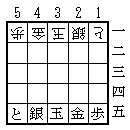

Kyoto shogi (京都将棋 kyōto shōgi, "Kyoto chess") is a modern variant of shogi (Japanese chess). It was invented by Tamiya Katsuya c. 1976.
Kyoto shogi is played like standard shogi, but with a reduced number of pieces on a 5x5 board. However, the pieces alternately promote and demote with every move, and the promotion values are entirely different from standard shogi.
Two players play on a board ruled into a grid of 5 ranks (rows) by 5 files (columns). The squares are undifferentiated by marking or color.
Each player has a set of 5 wedge-shaped pieces, of slightly different sizes. From largest to smallest (most to least powerful) they are:
| Piece | Kanji | Rōmaji |
|---|---|---|
| White king | 王将 | ōshō |
| Black king | 玉将 | gyokushō |
| Rook/pawn | 飛歩 | hifu |
| Silver-general/bishop | 銀角 | ginkaku |
| Gold-general/knight | 金桂 | kinkei |
| Lance/tokin | 香と | kyōto |
The names of the pieces combine their promoted and unpromoted values, and are puns in Japanese for words with the same pronunciations but different kanji. For example, the lance/tokin is homonymous with the name of the city 京都 Kyoto, and provides the name of the game.
 Setup
Setup
|
|
Each side places his pieces in the positions shown below, pointing toward the opponent.
That is, the first rank is:
| T | S | K | G | P |
There is no promotion zone in Kyoto shogi. Every time a piece makes a move it alternately promotes and reverts to its unpromoted state. Promotion is effected by turning the piece over after it moves, revealing the name of its promoted rank; demotion is effected by turning the piece back.
The promotion rules and values are reminiscent of microshogi and entirely different from standard shogi:
A piece is allowed to move, capture or be dropped in a manner that will prevent it from moving on a subsequent turn, which is illegal in standard shogi. For example, a rook can move onto the farthest rank, becoming a pawn and unable to move further. Such pieces may be captured as any other.
A captured piece may be dropped with either side facing up.